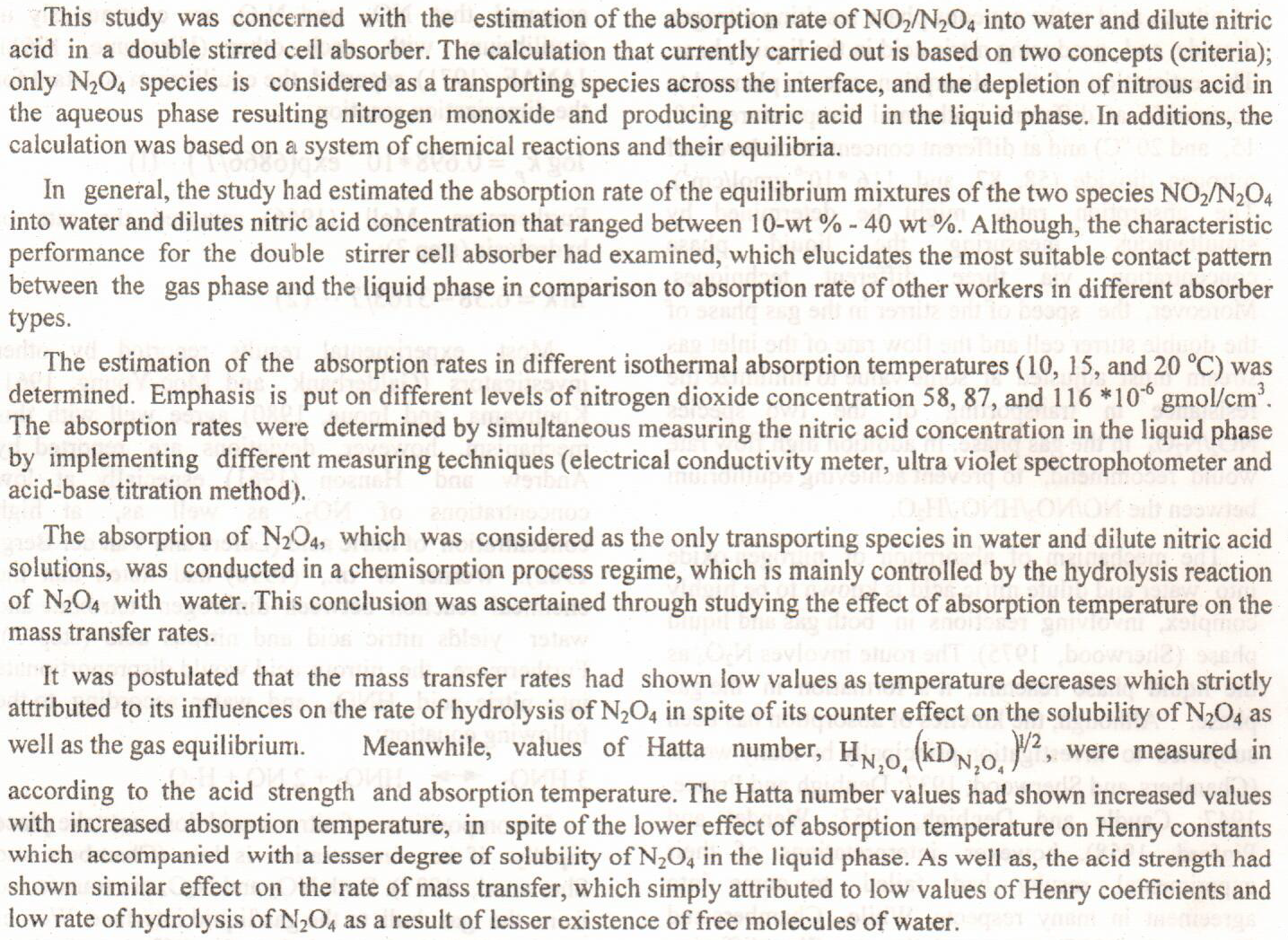
 (3)
(3)
The adsorption process of reactive blue 49 (RB49) dye and reactive red 195 (RR195) dye from an aqueous solutions was explored using a novel adsorbent produced from the sunflower husks encapsulated with copper oxide nanoparticle (CSFH). Primarily, the features of a CSFH, such as surface morphology, functional groups, and structure, were characterized. It was determined that coating the sunflower husks with copper oxide nanoparticles greatly improved the surface and structural properties related to the adsorption capacity. The adsorption process was successful, with a removal efficiency of 97% for RB49 and 98% for RR195 under optimal operating conditions, contact time of 180 min, pH of 7, agitation speed of 150 rpm, initial dye concentration
... Show More (20)
(20)
To achieve optimal plant growth and production under salt stress, some products were added in adequate quantities to give a good yield, especially bean plants which are sensitive to salinity. For this purpose, this experiment was carried out during the spring growing season in 2022 in Baghdad, to study the effects of humic acid, cytokinin, arginine and their interaction with 9 parameters that reflect the overall traits of vegetative growth and yield of common bean plants Phaseolus vulgaris L. var. Astraid (from MONARCH seeds, China). The factorial design with 3 replicates was used, each with 7 plants treated via foliar spraying or by addition to the soil. The first factor included three groups; H0, H1 and H2 (0, 6, 12 Kg.h-1 H
... Show More (2)
(2)
Schiff base N,N'-Bis-(4-dimethylamino-benzylidene)-benzene-1,4-diamine has been synthesized from 4-dimethylaminobenzenaldehyde and benzene-1,4-diamine. The structure of Schiff base was obtained by (C.H.N.) microanalysis, Mass, 1HNMR, FT-IR and UV-Vis spectral methods and thermal analysis. Metal mixed ligand complexes of some metal(II) salts with Schiff base ligand and anthranilic acid were prepared in the molar ratio (1:2:2), (Metal):(SBL)2:(Anthra)2, (SBL)= Schiff base ligand, (Anthra) =anthranilic acid and Metal= Co(II), Ni(II), Cu(II), Zn(II), Cd(II) and Hg(II). The thermal behaviour (TGA) of the complexes was studied. The prepared complexes identified by using mass, thermal analysis, FT.IR and UV-Vis spectrum methods, on otherwise flame
... Show MoreTwo experiments were carried out, the first at the College of Agriculture - University of Baghdad during spring season 2017 Everest cv. class (Elite) was used to study the effect of foliar application of calcium and magnesium and addition of humic acid to the soil on potato growth and yield, The layout of the experiment was factorial within RCBD design using three replicates. Calcium and Magnesium sprayed with concentrations (0, 500, 1000 mg.L-1), while the humic acid was added to the soil with (0, 0.75 gm.m2), The second experiment included storage of tubers produced from the spring season, with to study the effect of field treatments on improving the storability of the tubers. The results showed that the treatment of calci
... Show More (10)
(10)
 (1)
(1)
KE Sharquie, AA Noaimi, ZN Al-Khafaji…, Journal of Cosmetics, Dermatological Sciences and Applications, 2016 - Cited by 2
The apricot plant was washed, dried, and powdered after harvesting to produce a fine powder that was used in water treatment. created an alcoholic extract from the apricot plant using ethanol, which was then analysed using GC-MS, Fourier transform infrared spectroscopy, and ultraviolet-visible spectroscopy to identify the active components. Zinc nanoparticles were created using an alcoholic extract. FTIR, UV-Vis, SEM, EDX, and TEM are used to characterize zinc nanoparticles. Using a continuous processing procedure, zinc nanoparticles with apricot extract and powder were employed to clean polluted water. Firstly, 2 g of zinc nanoparticles were used with 20 ml of polluted water, and the results were Tetra 44% and Levo 32%; after
... Show More (3)
(3)
 (1)
(1)
Electrocoagulation process was employed for the treatment of river water flows in Iraq. In this study, a batch Electrocoagulation process was used to treat river water taken from Al - Qadisiyah water treatment plant. electrolysis time, voltage and inter-electrode spacing were the most important parameters to study . A statistical model was developed using the RSM model. The optimum condition after studying the parameter effect the process was 1 cm separating, 30 volts . The RSM model shows the ideal condition of removal for both the TSS and turbidity at 1 cm, 20 volts and 55 min.
 (1)
(1)
 (1)
(1)
